 Rens Heijnis custom-built audio equipment
Rens Heijnis custom-built audio equipment
Improve the sound of your Neumann microphone by retrofitting and separated power supply.
When you are not satisfied with the sound of your Neumann microphone: too sharp, strident, thin, lacking vibrancy
or anything else, it is possible to retrofit your microphone with better electronics to improve the sound.
Retrofitting is possible for nearly all Neumann condenser microphones such as KM86, KM100, KM184, M149, TLM49,
TLM50, TLM170 U87, U87, U89.
After retrofitting your microphone has a smoother sound, less sharp and strident, more vibrancy.
At the former microphones page you can read the theory about retrofitting:
Neumann also use the inferior sounding SMD printed circuit boards in his modern microphones.

The M149 is a good example of a microphone which is evolved to a circuit overloaded with SMD components
(despite 1 tube)
Reference from customer with a retrofitted M149:
"This is a significant improvement. You can "look through the sound" , transparent. With a bottom.
The "old" recordings sounded stashed away"
A retrofitted microphone has a new printed circuit board with trough-hole components.
All the components are selected for there proven sound quality.
Power Supply for active powered Neumann microphones
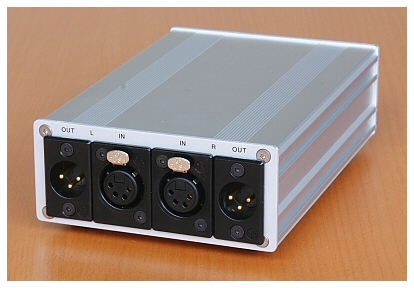
Technical Specifications PS-402
Number of channels: 2
Input: 4-pin XLR female connector
Output: 3-pin XLR male connector
Power requirements: 105-120V and 210-240V, 50 to 60 Hz
Power consumption max: 3W
Weight: 1 kg
Dimensions: 108mm × 165mm × 52mm (4.3” x 6.5” x 2.1”)
Microphone Cable for active powered microphones
A special microphone cable is necessary between the microphone and power supply.
The standard microphone cable is a Mogami starquad cable: Mogami 2534
For the +60V norm it is supplied with 4 pin XLR connectors.
Every cable length is available.
The output of the power supply is a normal 3 pin XLR.
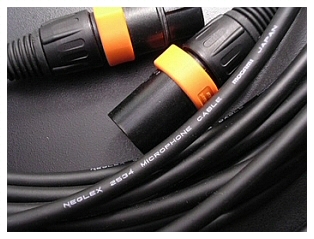
For microphone cables with an other sound than the Mogami see: Microphone Cables
Retrofitted Neumann KM133 with active power
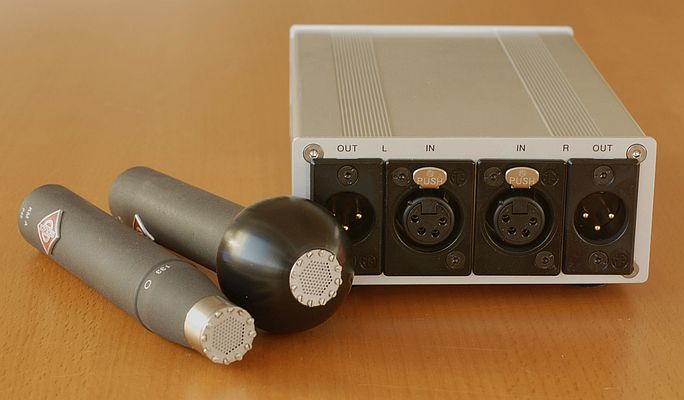
Neumann KM133, worth to retrofit.The sound lacks any vivid, the low frequencies are week,
a cold and hardness sound.
After retrofitting to 60V the sound is natural, very beautiful and vivid.
Retrofitted Neumann TLM49 with active power

It's worth to retrofit the TLM49: there is a beautiful capsule inside but the electronics is poor.
The sound lacks any vivid, the low frequencies are week, not natural at all.
After retrofitting to 60V the sound is natural, very beautiful and vivid.
Retrofitted Neumann M150 with active power
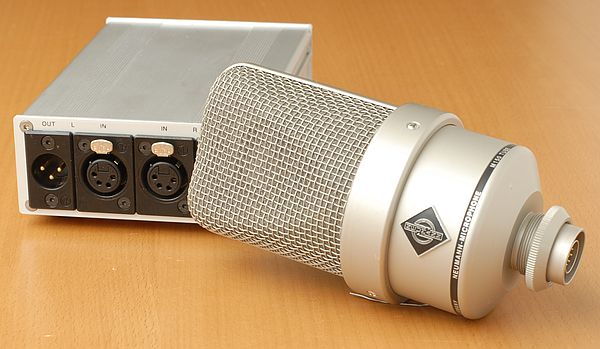
Neumann M150 retrofitted to active power. 2 channel power supply with 60V.
There is an abundance of electronics in the M150, so it's worth to retrofit.
Retrofitted Neumann KM100 with active power
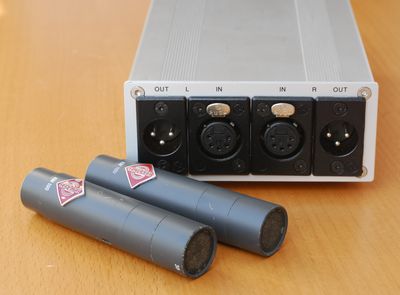
Neumann KM100 phantom retrofitted to active power. 2 channel power supply with 60V.
Due to the additional electronics in the head of the KM100, there is a major sound
improvement after retrofitting.
Retrofitted Neumann TLM170R and KM84 with active power
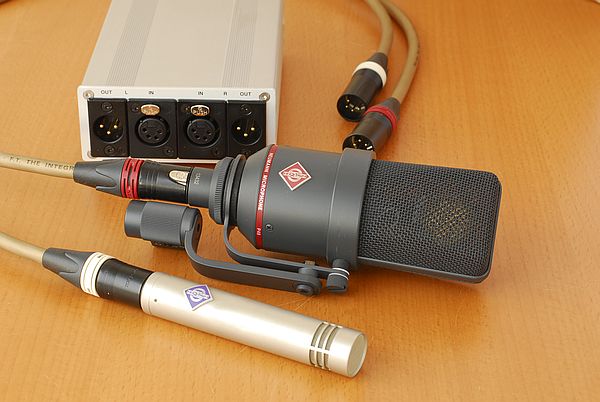
2 Neumann microphones retrofitted to active power: the good old KM84 and the modern TLM170R.
Both are worth to retrofit: the modern TLM170R due to large quantity of
electronics and
the KM84 due to the 1 Fet and transformer technology.
Retrofitted Neumann U87 with active power

Neumann U87ai phantom retrofitted to active power. 2 channel power supply with 60V.
This latest version of the U87 contains a PCB with SMD components result: a lifeless and sharp sound.
Also the representation of the middle frequencies are week.
Retrofitting your microphone with a new PCB with high end audio
components, separated power supply,
will remove the sharpness and will
balance the sound.
Retrofitted Neumann binaural stereo microphone KU100 with active power
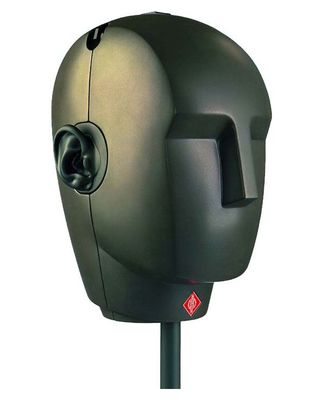
The sound of the Neumann KU100 is very dull and lifeless.
Retrofitting your KU100 with a new active powered PCB
(L and R 4 pin XLR, +60V) will result in an sparkling and natural sound.
A far better stereo image will appear.
Battery powered pre-amplifier for active powered Neumann microphones
Sonodore MPB-502
Pre-amplifier for standard B&K /DPA Microdot and active powered Neumann microphones
Special light weight (2,9kg) 3 channel pre-amplifier with Lithium ion batteries and the latest developments in improved
sound quality. With DPA MircoDot (4060serie) and active (6pin) microphone input. With battery power for the microphones.
Recording time 34 hours with active microphones, 43 hours with only DPA MicroDot.
Back view
A few examples of modifications to Neumann microphones:
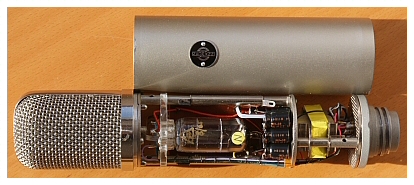
Modified Neumann UM57 microphone: the original sound
was sluggish, dull and to little low frequencies.
After modification, the microphone is now fuller,
more responsive and a more richer sound.
Modified Neumann UM57 microphone with new power supply
The polar pattern can be set infinity between omnidirectional,
cardioid, and figure 8
Audio samples
Martin Y Soler, L'innocenza. Mariví Blasco & Javier Somoza.
Recorded by Gonzalo Noqué with Retrofitted Neumann U89 (60V) in wide cardioid.
Horus preamp and converter
24bits 96KHz Audio sample
Reference on retrofitted Neumann M150 microphone with an active 60V PCB.
Jean-Daniel Noir:
First big recording with the new M150 “Sonodorized” as main
microphone with baroque orchestra choir
and soloists (Lorenzo Ghirlanda “Alexander Fest” in Michaelstein (D)
Everybody can imagine how much your main instrument, as you use
it for 20 years, is fundamental and
how much it is a risk to give it to
replace an essential part of this heart of your system.
No regrets ! They are really quiet, and
the sound is more tender as before,
still rich and very precise but
less aggressive, and this is perfect ?
Reference on retrofitted Neumann TLM49 microphone with an active 60V PCB.
G. MacFadden
I think it sounds great. I was able to hear what I would describe as a
smoothness in the mids and high mids
that was not evident on the stock TLM49.
I also noticed that, while working at the same distance from the microphone, I could hear a lot less sibilance.
I pulled the audio up in the editing software (Izotope RX11) and
reviewed the spectrogram.
In comparing today’s file to a previous file
recorded with the TLM49, it appears that there is more dynamic range,
but that the mid and upper frequencies are not as boosted as before.
I
have the sense that overall the frequency
response on your modification
is closer to the largely flat response of a Neumann U67 that I’ve used
at a commercial
studio in the past. Missing is the boost around 5khz and
dip at around 8kHz of the stock TLM49.
Overall, I’m very pleased with the modifications you made to the microphone.
Price list retrofitting microphones




















